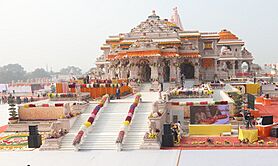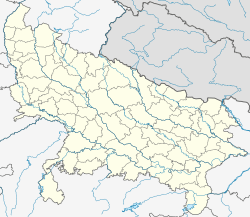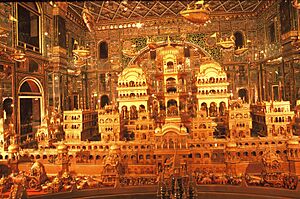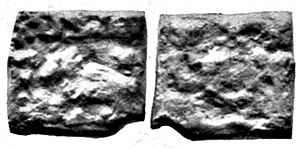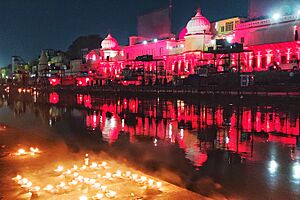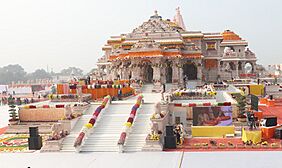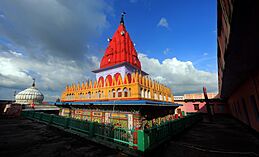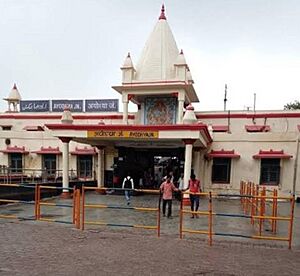Ayodhya facts for kids
Quick facts for kids
Ayodhya
|
|
|---|---|
|
City
|
|
|
|
|
| Nickname(s):
The Temple Town
|
|
| Country | |
| State | Uttar Pradesh |
| Division | Ayodhya |
| District | Ayodhya |
| Government | |
| • Type | Municipal Corporation |
| • Body | Ayodhya Municipal Corporation |
| Area | |
| • Total | 120.8 km2 (46.6 sq mi) |
| Elevation | 93 m (305 ft) |
| Population
(2011)
|
|
| • Total | 55,890 |
| • Density | 462.67/km2 (1,198.3/sq mi) |
| Demonym(s) | Ayodhyawasi, Awadhwasi |
| Language | |
| • Official | Hindi |
| • Additional official | Urdu |
| • Regional | Awadhi |
| Time zone | UTC+05:30 (IST) |
| PIN(s) |
224001, 224123, 224133, 224135
|
| Area code(s) | +91-5278 |
| Vehicle registration | UP-42 |
Ayodhya is a historic city in the Indian state of Uttar Pradesh. It sits on the banks of the Sarayu River. Ayodhya is a very important city for the Ayodhya district and Ayodhya division in Uttar Pradesh. In the first half of 2024, it became the most popular tourist destination in Uttar Pradesh. It welcomed 110 million visitors, even more than Varanasi.
Long ago, Ayodhya was known as Saketa. Important religious leaders like Gautama Buddha and Mahavira visited and lived here. Jain texts also say that five tirthankaras (great spiritual teachers) were born in Ayodhya. These include Rishabhanatha, Ajitanatha, Abhinandananatha, Sumatinatha, and Anantanatha.
Many people believe that Ayodhya is the legendary city mentioned in the ancient epic Ramayana. In this story, it is the birthplace of the Hindu deity Rama. Because of this, it is one of the seven most important pilgrimage sites for Hindus. A long-standing disagreement about a religious site in Ayodhya was settled in 2019. The Supreme Court of India decided that the land should be used to build a Hindu temple. It also ordered the government to provide land for a new mosque. The construction of Ram Mandir began in August 2020. The temple was officially opened on January 22, 2024.
In 2023, Ayodhya set a new Guinness World Record during its Diwali celebration. People lit 2,223,676 oil lamps, breaking the previous record.
Contents
What Does Ayodhya Mean?
The name "Ayodhya" comes from an old Sanskrit word. It means "not to be fought" or "invincible." This means it's a city that cannot be conquered. An ancient Jain poem also says Ayodhya is unconquerable by enemies.
The city's older name was "Saketa." This name might mean "with houses" or "with banners." The city was also called "Kosala" because it was the capital of the ancient Kosala kingdom. The cities of Ayutthaya in Thailand and Yogyakarta in Indonesia are named after Ayodhya.
A Look at Ayodhya's Past
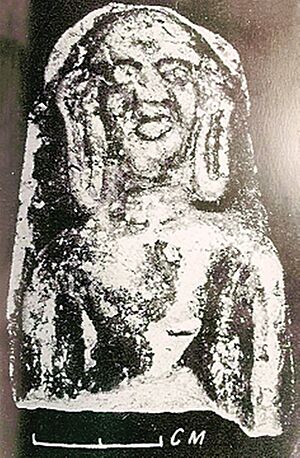
Ancient Indian stories like the Ramayana and Mahabharata talk about a legendary city called Ayodhya. This city was the capital of the Ikshvaku kings, including Rama.
Historians believe that the area where Ayodhya stands today became a city around 500 or 600 BC. This city was called Saketa. It was an important marketplace where two major trade routes met. Early Buddhist and Jain texts mention Saketa as a significant city in the Kosala kingdom.
Leaders like Gautama Buddha and Mahavira visited Saketa. They found it to be a busy town with many travelers. During the rule of Emperor Ashoka (around 200 BC), several Buddhist buildings might have been built here. Archaeologists have found a large brick wall, which was likely a fortification wall from that time.
After the Maurya Empire, Saketa was ruled by different kings. Coins from kings with names ending in "-mitra" have been found in Ayodhya. This shows that the city was an important center.
The Gupta Period
Around the fourth century AD, the Gupta rulers took control of the region. They helped bring back Brahmanism, an older form of Hinduism. During this time, Saketa became known as the legendary city of Ayodhya. The Guptas may have even moved their capital to Ayodhya.
One theory suggests that a Gupta emperor, possibly Skandagupta, moved the capital to Ayodhya. This might have been because of floods in their old capital or to stop invaders. It also helped the emperor connect himself to the legendary King Rama.
Later Periods
In the 11th century, the Gahadavala dynasty ruled the area. They built many Vishnu temples in Ayodhya. Over time, the worship of Rama grew, and he became a very important form of Vishnu. Ayodhya's importance as a pilgrimage site increased between the 13th and 18th centuries.
Later, under Mughal rule, the Babri mosque was built in Ayodhya. The city was the capital of the province of Awadh. After the Mughal rule weakened, Awadh became almost independent.
Ayodhya in Modern Times
In the 1850s, there were disagreements about the Babri mosque site. Some Hindus believed it was built where the Hindu deity Rama was born. To keep peace, the British rulers divided the area between Hindus and Muslims.
After India became independent, a movement started in 1984 to build a Rama temple at the site. In 1992, a large gathering led to the destruction of the mosque. A temporary temple for Ram Lalla (infant Rama) was then built.
In 2003, archaeologists dug at the site. They found evidence of pillar bases, suggesting a temple had been there before the mosque. In 2019, the Supreme Court of India made a final decision. It ruled that the land should be given to a trust to build the Ram Mandir. The court also ordered the government to give land for a new mosque in a different area.
On August 5, 2020, the Prime Minister of India, Narendra Modi, laid the foundation stone for the new Ram Mandir. This grand temple was officially opened on January 22, 2024.
Some people in South Korea believe that an ancient Korean princess, Heo Hwang-ok, came from Ayodhya. In 2001, a memorial was built in Ayodhya to honor this connection.
People of Ayodhya
According to the 2011 Census of India, Ayodhya had a population of 55,890 people. Most people in Ayodhya are Hindu (93.23%), and Muslims make up the second largest group (6.19%). The city has a good literacy rate of 78.1%.
Weather in Ayodhya
Ayodhya has a humid subtropical climate. This means it has long, hot, and dry summers from March to June, with temperatures around 32°C (90°F). After that, the monsoon season brings rain until October, with average temperatures around 28°C (82°F). Winters are mild, from November to January, with temperatures around 16°C (61°F).
Must-See Places in Ayodhya

Ayodhya is a very important place for Hindu pilgrims. It is considered one of the seven holiest cities in India.
Ram Mandir: A Sacred Temple
The Ram Mandir, also known as Shri Ram Janmabhoomi Mandir, is a large Hindu temple complex. It is being built where many Hindus believe their god Rama was born. The main deity inside the temple is Balak Ram, which means the Infant form of Rama. The temple was officially opened on January 22, 2024.
Hanuman Garhi Fort: A Place of Protection
Hanuman Garhi is a large, four-sided fort with round towers. Inside, there is a temple dedicated to Hanuman, a Hindu deity known for his strength and devotion. It is the most popular shrine in Ayodhya. Legend says that Hanuman lived here to protect the birthplace of Rama. Many people believe that wishes come true if you visit this shrine.
Kanak Bhawan: A Royal Gift
Kanak Bhawan is a beautiful temple. It is believed that Rama's stepmother, Kaikeyi, gave this temple to Sita and Rama as a wedding gift. The temple only has statues of Sita and her husband, Rama.
Ramkot: The Ancient Citadel
Ramkot is a main place of worship in Ayodhya. It is the site of an ancient fort, located on high ground. Many pilgrims visit Ramkot throughout the year, especially during "Ram Navami." This festival celebrates the birth of Rama and happens in March or April.
Nageshwarnath Temple: A Son's Devotion
The Nageshwarnath Temple was built by Kush, the son of Rama. The story says that Kush lost his armlet in the Sarayu. A snake-maiden found it and fell in love with him. Since she was a devotee of Shiva, Kush built this temple for her. It is said to be the only temple that survived when Ayodhya was abandoned long ago. The festival of Shivratri is celebrated here with great joy.
Other Interesting Spots
- Brahma Kund
- Ram ki Paidi
Memorial of Heo Hwang-ok
The legendary princess Heo Hwang-ok from ancient Korea is believed by some to have come from Ayodhya. In 2001, a memorial was opened in Ayodhya to honor her.
Sister Cities
 Gimhae, South Korea
Gimhae, South Korea
- Ayodhya and Gimhae became sister cities in 2001. This was based on the belief that Princess Heo Hwang-ok came from Ayodhya.
 Janakpur, Nepal
Janakpur, Nepal
Getting Around Ayodhya
By Road
Ayodhya is well-connected by roads to many big cities. These include Lucknow (130 km), Gorakhpur (140 km), Prayagraj (160 km), Varanasi (200 km), and Delhi (636 km). There is also a direct bus service between Ayodhya and Janakpur in Nepal. This route is part of the Ramayana circuit, connecting important places from the epic story.
By Rail
The city has two main railway stations: Ayodhya Junction and Ayodhya Cantt. They are on the Northern Railway line, connecting to major routes. A special "Ramayana Circuit Train" also runs from Delhi to important sites related to the Ramayana story.
By Air
The closest airport is Maharishi Valmiki International Airport, Ayodhyadham, just 5 km away. Other nearby airports include Chaudhary Charan Singh International Airport in Lucknow (134 km away) and Prayagraj Airport (166 km away).
See also
 In Spanish: Ayodhya para niños
In Spanish: Ayodhya para niños


